Micro-Trains Line Heavyweight Horse Car
Published: 2024-10-01 - By: CNW400
Last updated on: 2024-09-18
Last updated on: 2024-09-18
visibility: Public - Headline
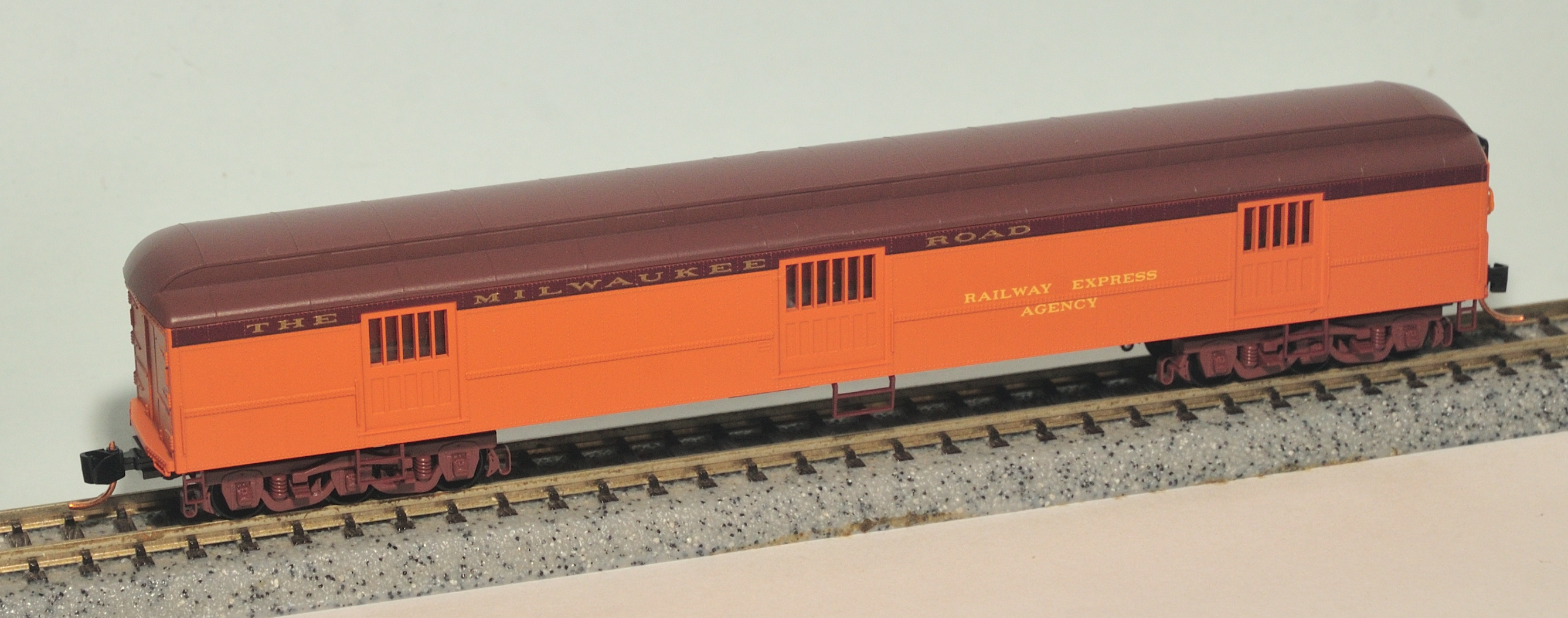
The Prototype
Horse cars were a specialty piece of railroad equipment used to transport racing and show horses to their destination – racetrack, equestrian exhibition, circus, or simply to home. Back in the day before improved interstate roads and the rise of the trucking industry; railway transportation was a quick, easy, and economically friendly method for the finest show and racing horses to travel from coast to coast.The Chesapeake and Ohio Railway (C&O) and Southern Pacific (SP) were among the first railroads to adopt this service…purchasing specifically constructed heavyweight horse cars with distinctive fishbelly underframes from St. Louis Car Company in 1937. Furthermore, both rail lines converted Pullman Company or American Car and Foundry (ACF) all-steel heavyweight parlor cars and coaches into horse carrying cars during the early 1940s. These conversions were completed with recommendations from the Horsemen’s Transportation Association to assure the safety and comfort levels of the animals.
The classic horse car was 82-feet long over the buffers with an interior length of 78-feet long. They typically had a light weight of 164,000 pounds with 736 square feet of room. The railcars were all-steel construction with anti-telescoping end frames to minimize injury in the event of a derailment or crash. The cars were able to accommodate 24 horses with stalls arranged in six sections with four horses in each area. But commonly, 12 to 16 were transported at one time.
The cars were heated and insulated to regulate the internal temperature. There were three all-steel doors on each side with screened drop-down windows to provide ventilation. There was one large center door and smaller doors over each truck. No other side windows were present as to not startle the horses from a passing train or other distraction. The floors were double thick hard pine with recessed drains to allow urine to discharge out the bottom of the car. The interior of the cars was commonly painted a neutral color of light tan or white. A series of twelve exhaust ventilators lined the arch-shaped roof on each side of the horse car.

One end of the rail car had a full-sized swinging steel door to allow for loading of automobiles and equipment for the horses. This heavy-duty door was fitted with double locking bars on each section of the door. The automobile side had a smaller 2’-6” sliding door set within the large end door. The opposite end had a 3-foot sliding door. At first, the horse car was equipped with a 360-gallon (soon upgraded to 500-gallon) air pressure water system tank (A.P.W.S.).
Furthermore, the horse car rode on six-wheel trucks with roller bearing cast-steel frames. A 32-volt axle generator supplied the power for lighting inside the car. A 16-cell auxiliary battery worked in tandem with the generator system. Lastly, the car was equipped with Type-E cast-steel couplers. A handbrake was attached on the exterior at one end and another handbrake was mounted on the interior of the car for operation from the inside.

The interior of the horse car was shared with the animals, their supplies & equipment, and their handlers. Much of the car had stall arrangements for the horses with hay bars to hang their feedbags and water buckets. Also aboard was hay and feed, along with any racing and show equipment (saddles, blankets, jumping bars, polo accessories, etc.). Caretakers and horse trainers slept on one end of the car on portal cots with train provided watercooler, washstand and toilet facilities. Since most horse cars carried the owners of premier equine passengers, they often ran on special service luxury trains – affording the horse owners the opportunity to travel in high-style with extravagant accommodations a few cars back from the animal cars.
The Santa Fe Railway established their horse express service in 1951 with stops at Del Mar and Santa Anita Racetracks. The Santa Fe converted all-steel heavyweight coach cars into “Fine Cars for Fine Horses” per their industry advertisements. This service lasted on Santa Fe lines until 1972.
Horse cars were customarily arranged at the front of the train near the locomotive, allowing uncomplicated switch-out of the cars at interchanges or their destination (racetrack / fairgrounds). Also, cars close to the head of the train experience a smoother ride with less slack action – reducing stress on the horses.
By the 1960s, the horse railcar started to fall out of favor with the animal owners. The reduction of passenger service by the major railroads, stricter Federal laws regulating the transport of animals by rail, and the belief that travel by train was not beneficial to the health of the horse were some of the factors leading to the demise of the horse car. Horses are now transported by truck in standing- or box-stall trailers. Many of the horse cars were rebuilt into regular express, baggage service, or Maintenance of Way (MOW) equipment. Express agents fancied these railcars with their three large doors on each side of the car – allowing for quick loading and unloading of shipments. Southern Pacific #7233 extended its life as an animal carrier hauling large zoo animals from 1965 to 1971 before retiring from revenue service.

One of the most famous horses of all, Seabiscuit, traveled over 50,000 miles by rail during the 1930s. The 1938 American Horse of the Year rode with his emotional support companion Pumpkin, from his home state of Kentucky with much fanfare and marketing publicity to the grand racetracks of California. The ‘Seabiscuit Limited’ was a popular passenger train service that brought racing fans to racetracks to watch Seabiscuit compete.
Pricing & Road Names
Micro-Trains Line introduced the Heavyweight Horse Car in 2016 with a suggested retail price at that time of $29.95. Since then, Micro-Trains has released twenty-five unique production models of the Heavyweight Horse Car including the following road names:- Baltimore & Ohio
- Canadian National
- Canadian Pacific
- Chesapeake & Ohio
- Milwaukee Road
- New Haven
- New York Central
- Pennsylvania Railroad
- Ringling Bros. and Barnum & Bailey
- Santa Fe
- Southern Railway
- Southern Pacific
- Union Pacific
- Undecorated
My review includes observations of Micro-Trains Line 149-00-120… The Milwaukee Road Horse Car released in May 2017 with a suggested retail price of $30.90.
The Model
The Micro-Trains Line horse car was packaged in an oversized clear plastic jewel case with a slip-off cover and a one-piece plastic cradle to cushion the model. The model information is clearly labeled on the end of the case for ease to locate when in storage. There is a brief history of the model prototype on the back panel. Furthermore, a thin, rigid plastic sheet covered the exposed side to protect the railcar from scratches. No additional pieces were found in the case. But oh no --- I heard that dreadful loose part jangle when moving the jewel box around. What was making that sound? More on that later.
The Milwaukee Road railcar sports the familiar orange with maroon band color scheme. The paint job is clean and bold along the entire injection molded plastic model. The gold and yellow lettering is sharp and neat. The model is lacking road markers, road numbers and/or car name. No data information is stenciled on the car.
Although advertised as a horse car – what we really have is a 70-foot American Car and Foundry (ACF) heavyweight car converted to Railway Express Agency duty after being retired from equine service. It also appears to be a fantasy paint scheme with no prototype images or references found mentioning Milwaukee Road horse car railcars.
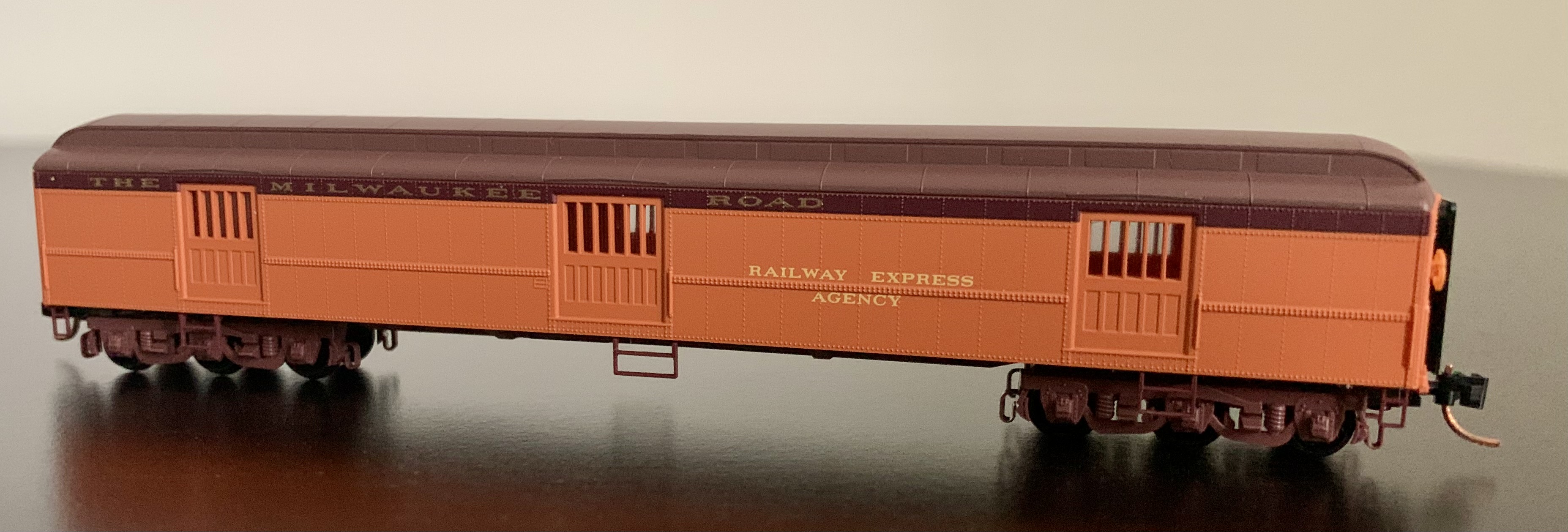
The bright orange sides exhibit sharp rivet steel panel detail but disappoint with poorly molded grab irons and handrails. The Micro-Trains horse car has the prototype correct three side door pattern – one larger center door with smaller doors above each truck. The model doors are non-operational but have clear window glazing. Each side has five stirrup steps – one near each end and larger stirrups below each door.
The B-end features additional crisp steel panel rivet lines with a separately applied scalloped Miner brake wheel with six spiral spokes and molded chain detail. The access door is surrounded by an unremarkable black end diaphragm and additional molded hardware piece. The A-end represents the full swinging open-end door for oversized loads with large molded hinges and latches. Prototype correct smaller entry door is also portrayed.
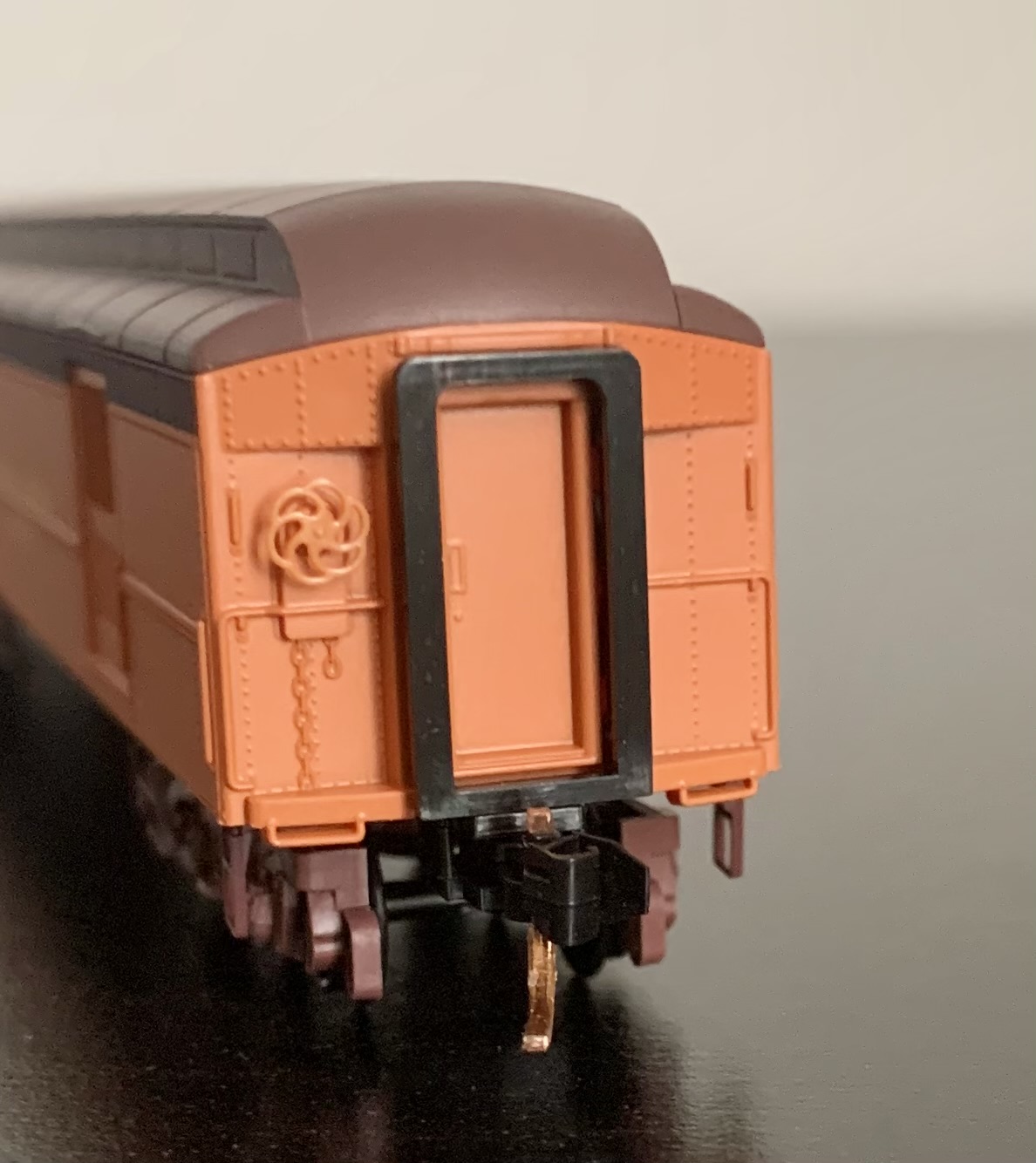
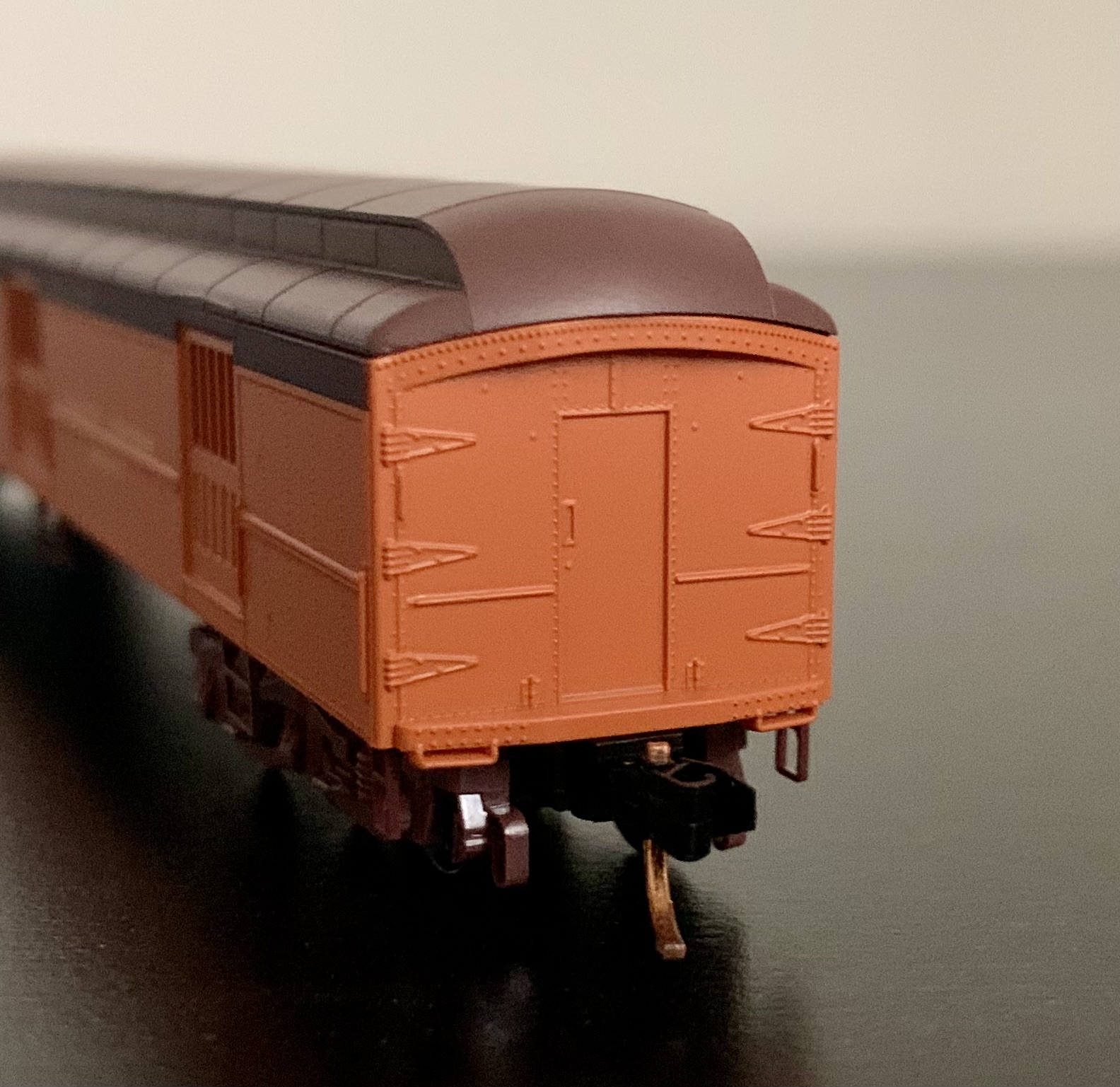
The maroon roof does feature the era and horse car correct clerestory design. A clerestory roof is characterized by a raised section with windows and/or vents along the sides. Windows provided natural light and ventilation. The heightened roof area also allowed hot air to rise and escape through vents. The Micro-Trains Line is missing the twelve exhaust ventilators and roof corner grab irons found on this type of railcar. Prototype images show both Southern Pacific and Union Pacific heavyweight cars with the exhaust ventilators still functioning even after their horse car service days.

The brown underside features an elaborate configuration with water tanks, service reservoir, emergency reservoir, auxiliary reservoir, and steel battery box. Molded brake pipe, cross bearers, and center sill. The heavyweight car runs on two 3-axle trucks with black plastic wheels. The railcar is also equipped with proper height body-mounted Magne-Matic Knuckle couplers.

The car weighs 1.1 ounces and measures 5 5/8 inches in length. While this weight is a tad light according to the National Model Railroad Association (which are 1.3 - 1.4 ounces), I found it a good running car on Kato Unitrack with no issues around curves or through turnouts at low and medium speeds. A minimum operating radius of 14” is recommended.
Oh yeah – what was that rattling sound? Probably my biggest compliant with the assembly of this model…how the stirrups are attached, or shall we say not attached. At first, I noticed a stirrup was loose and free inside the jewel case. Seeing that the bracket was ‘L’ shaped with a pin hole, I removed the underside panel and discovered that the stirrups were not attached very well. No adhesive was used, and the post meant to hold the bracket was much too small. Nothing a little model glue on all six parts won’t fix – but a project I didn’t expect. But wait – that wasn’t the only problem. Something was still rattling back-n-forth inside the orange body cavity. Instead of disassembling the model further, I with just leave well enough alone and live with a hard piece of plastic moving about inside the car body.
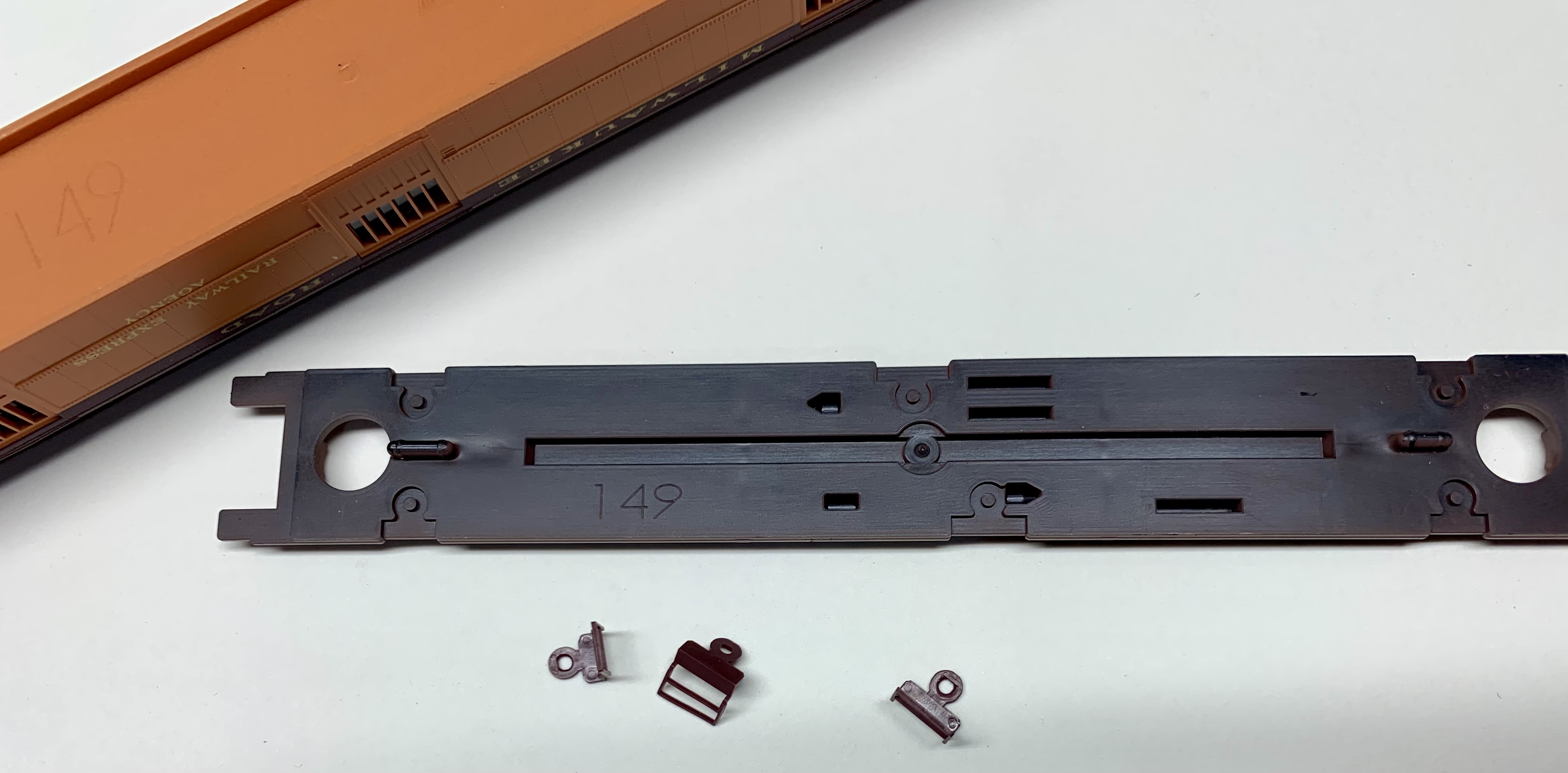
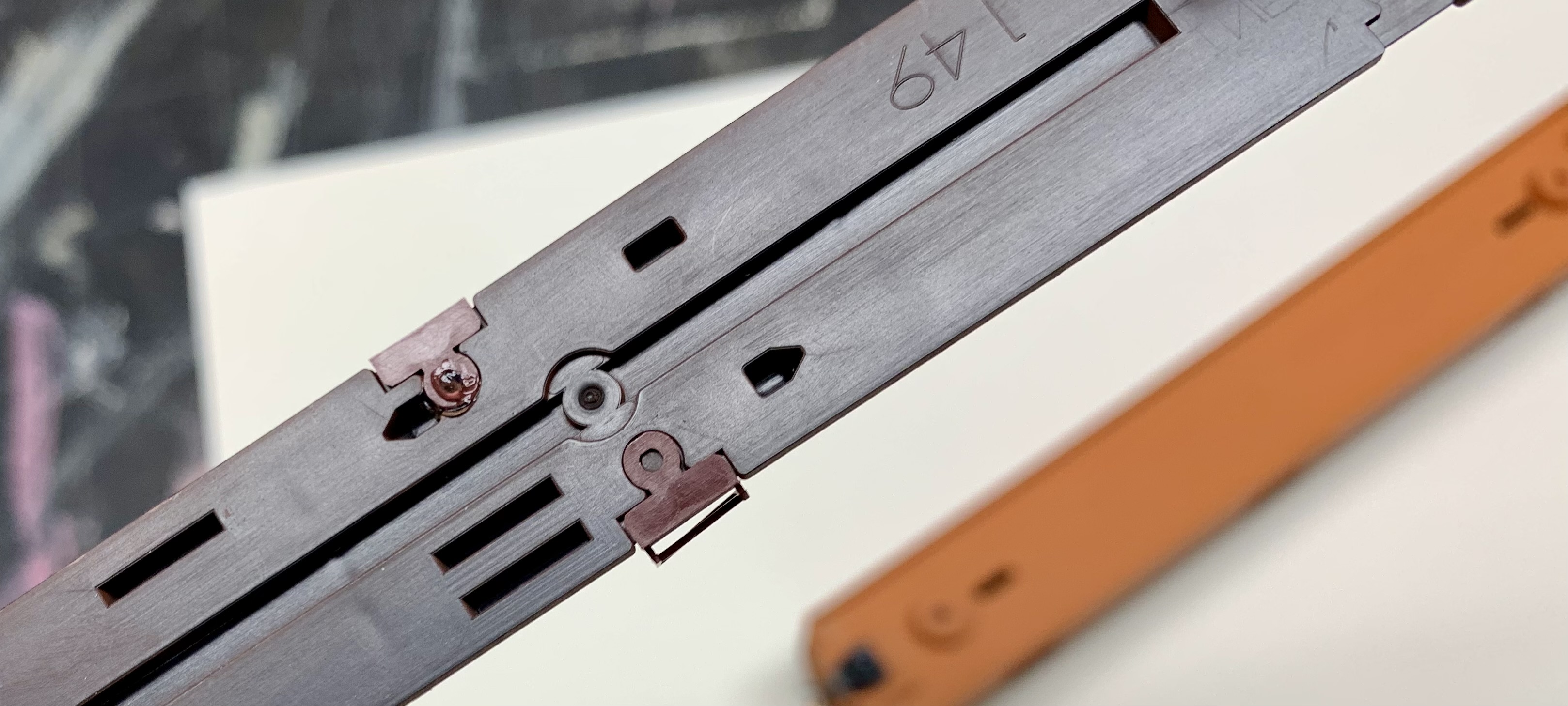

In conclusion, Micro-Trains Line produces a nice baggage express model. A few more prototypical accurate converted horse car details would make it exceptional. A sharp looking railcar that runs well. But missing roof details, molded parts, and a repair because of poor design knocks it down the scale for me. The Micro-Trains model came fast out of the gate but failed down the back stretch.
To Review the Entire Collection of Micro-Trains Line Horse Cars: CLICK HERE
Photo Credits:
Seabiscuit and Tom Smith (Seabiscuit Heritage Foundation) The photos supplied by the Seabiscuit Heritage Foundation are public domain, since they were published in the United States between 1923 and 1963 without a copyright notice or the copyright was not renewed. www.commons.wikimedia.orgAll other photographs were taken by the author.

